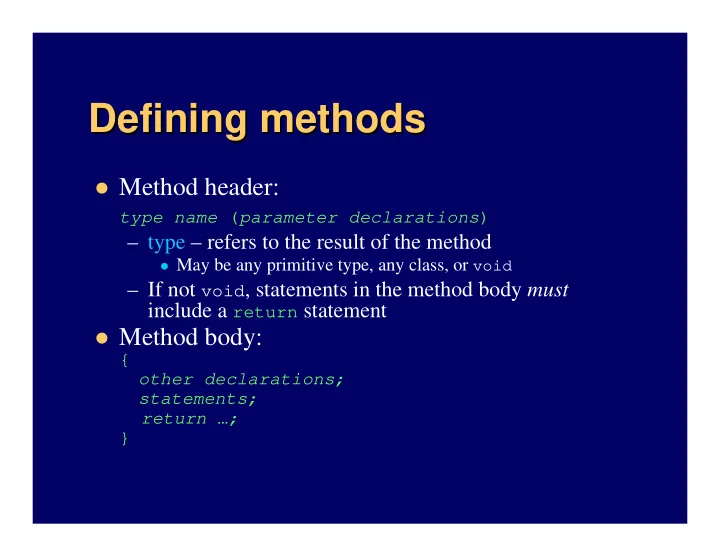

Defining methods Defining methods � Method header: type name ( parameter declarations ) – type – refers to the result of the method � May be any primitive type, any class, or void – If not void , statements in the method body must include a return statement � Method body: { other declarations; statements; return …; }
Some notes about return Some notes about return � Can return if void method too – early exit � One method can have multiple return s – Just the first one encountered is executed, so usually used within selection structures – Compiler checks that every branch has one � Actually returns a copy of a local variable int result = …; return result; // caller gets a copy of result
Scope/duration of variables Scope/duration of variables � Depends on where declared – i.e., in which set of {} ; in which “block” � Declared in class block (instance/class variables): – Duration (“lifetime”): same as duration of object – Scope: available throughout the class � Declared in method or other block (including formal parameters): – Duration: as long as block is being executed – Scope: available just within the block
Arguments vs. parameters Arguments vs. parameters � In Java, arguments are always passed as copies � e.g., imagine 3 mystery methods f1 , f2 and f3 , and these data: int x = 5, y[] = {3, 92, 17}; Rectangle r = new Rectangle(5,5,5,5); – Some things are certainly true about f1 , f2 and f3 . For example: f1(x); // int value � f1 cannot change x (parameter is a copy) f1(y[0]); // also an int value � f1 cannot change y[0] f2(r); // a reference � f2 cannot aim r at a different Rectangle // but can change the Rectangle object that r references f3(y); // an array reference � f3 cannot aim y at another array // but can change the elements of the array that y references
About static About static � Meaning in Java: “same for all objects of a class” – So static methods are “class methods” and static variables are “class variables” � static methods do not operate on an object – So cannot access instance variables – Only have explicit parameters (no this ) � static data common to all objects of a class – e.g., if (Martian.count > 10) attack(); – Can be accessed by static methods – Careful though: often misused like “global” variables
Overloading methods Overloading methods � Method signature: name (parameter list) – Overloading means reusing the name with a different parameter list � i.e., different number, types, and/or order of parameters – Cannot distinguish by different return type alone � e.g., three utility print methods void pr() { System.out.print(“standard”); } void pr(String s) { System.out.print(s); } void pr(int x) {System.out.print(“Num: “+x);}
Wednesday, 10/29 Wednesday, 10/29 Midterm exam Midterm exam
Pre- - and post and post- -conditions conditions Pre � Pre-conditions – what must be true to use method – Usually are restrictions on the values of parameters � e.g., x must not equal zero in divideBy(int x) – Should throw exception if violated (more on this later) � Post-conditions – what is true after method used – Here checking on accuracy of method’s algorithm � Together they constitute a type of contract – Both should be clearly stated in method comments
Combining methods – – classes classes Combining methods � Good designs split responsibilities meaningfully – “Good” = adaptable, extendable, not error-prone, … – Not just splitting work between methods � Also means splitting methods between classes � Start by choosing appropriate classes – not easy! � Then assign responsibilities to classes – According to good design principles � e.g., high cohesion – all members of a class are related � e.g., low coupling – few interactions between classes � Note: this is just an intro – much more in CS 50
Access/mutation of private data Access/mutation of private data � Information knowing is a type of responsibility – Translates to instance and class variables � Should be private – according to information hiding principle � So usually provide accessor methods – getX() � And maybe mutator methods – setX(val) – Unless want immutable objects – String , Double , … � Note: best to avoid “side effects” – i.e., unexpected changes to parameters or 3 rd classes – At least be sure to advertise as post-conditions
Combining classes – – packages packages Combining classes � Uppermost level of Java modules – Used to bundle related classes – a good design – Also a mechanism for “namespaces” � Declare in each class – package my.stuff; � Store all in same directory – ./my/stuff/ � Must qualify class names to use them – Either explicitly each time name is used – my.stuff.Thing – Or import my.stuff.Thing; – Or import my.stuff.*; //get all classes in package � See text section 8.9 and “How To” 8.1
Recommend
More recommend